Results
Sorry! Please try again
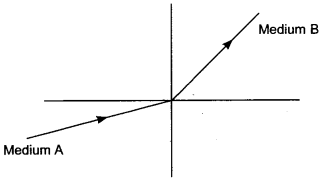
#1. A light ray enters from medium A to medium B as shown in figure. The refractive index of medium B relative to A will be
(a) Here, ∠i = 60°, ∠r = 45°
Using Snell’s law of refraction, refractive index of medium B with respect to medium A.
n=sin i / sin r
=> sin 60 / sin 45
=> √3/√2
#2. A magnified real image is formed by a convex lens when the object is at
Explanation: (d) When object is at 2F, real inverted and same size image is formed by convex lens. So, according to question option (1) and (2) both are correct.
#3. In torches, search lights and headlights of vehicles the bulb is placed
Explanation: (b) When source of light is placed very near to the focus of the reflector, which are concave in shape, the reflected light becomes parallel to the principal axis.
#4. When the object is placed between f and 2f of a convex lens, the image formed is
#5. A point object is placed at a distance of 20 cm from a convex mirror of focal length 20 cm. The image will form at:
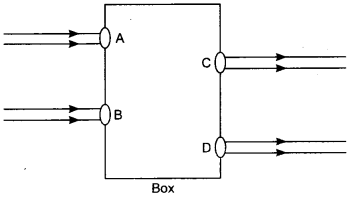
#6. Beams of light are incident through the holes A and B and emerge out of box through the holes C and D respectively as shown in the figure. Which of the following could be inside the box?
Explanation: (a) Figure shows that emergent ray are parallel to the incident ray and shifted side ward slightly. This can be done by the rectangular glass slab only.
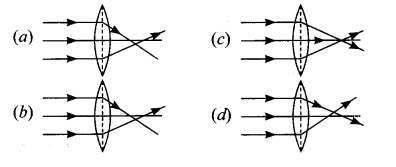
#7. The distance between the optical centre and point of convergence is called focal length in which of the following cases?
Explanation :(c) Parallel rays after refiracting meet at the focus of a convex lens.
#8. When light falls on a smooth polished surface, most of it

#9. A student does the experiment on tracing the path of a ray of light passing through a rectangular glass slab for different angles of incidence. He can get a correct measure of the angle of incidence and the angle of emergence by following the labelling indicated in figure:
#10. An object at a distance of + 15 cm is slowly moved towards the pole of a convex mirror. The image will get
Explanation: (d) Convex mirror always formed virtual and diminished image.
#11. If an incident ray passes through the focus, the reflected ray will
#12. Magnifying power of a concave lens is
#13. If the image is formed in front of the mirror, then the image distance will be
#14. The image formed by concave mirror is real, inverted and of the same size as that of the object. The position of object should be
Explanation:(c) When object lies at C of a concave mirror, image is also formed at ‘C’ and having same size real and inverted.
#15. If a man’s face is 25 cm in front of concave shaving mirror producing erect image 1.5 times the size of face, focal length of the mirror would be
Explanation: (a) In concave shaving mirror, virtual erect and large size image, behind the mirror is obtained, using
m=-v/u=> 1.5=-v/(-25)
- V=75/2 Cm
Now for Mirror Formula
1/f=1/v 1/u = 1/(75/2) 1/(-25)=-1/75
So f= -75 Cm
Hence, focal length of concave mirror is 75 cm.
#16. Magnification produced by a rear view mirror fitted in vehicles
Explanation: (a) Convex mirror is used as rear view mirror and always forms virtual, erect and diminished image. So magnification produced by a rear view mirror is less than one.
#17. Focal length of a concave mirror is
#18. A concave mirror of focal length 20 cm forms an image having twice the size of object. For the virtual position of object, the position of object will be at
Explanation: (c) For virtual image,
M=-v/u = 2 => v=-2u
As 1/u=1/v 1/f
So 1/u 1/(-2u)=1/(-20)
- 1/2u=1/(-20)
- U=-10cm
#19. A spherical mirror and a spherical lens each have a focal length of -10 cm. The mirror and the lens are likely to be
#20. Light from the Sun falling on a convex lens will converge at a point called
Explanation: (b) The parallel ray coming from the sun, after refraction through the convex lens converge at its focus.
#21. The angle of incidence for a ray of light having zero reflection angle is
Explanation: (a) For reflecting surface ∠i = ∠r
#22. The nature of the image formed by concave mirror when the object is placed between the focus (F) and centre of curvature (C) of the mirror observed by us is
Explanation: (c) When object lies between C and F, the real, inverted and enlarged image is formed beyond C.
#23. The laws of reflection hold good for
Explanation: (d) The laws of reflection hold good for light reflected from any smooth surface irrespective of their shapes.
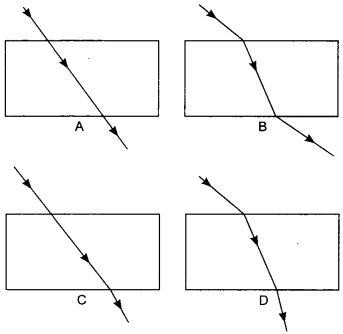
#24. The path of a ray of light coming from air passing through a rectangular glass slab traced by four students are shown as A, B, C and D in figure. Which one of them is correct?
Explanation: (b) When a light ray is incident obliquely on one face of rectangular glass slab, the emergent ray will be parallel to the incident ray and shifted sideward slightly.
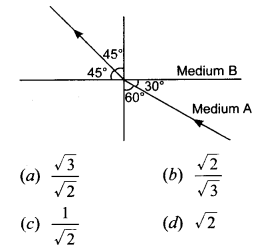
#25. Figure shows a ray of light as it travels from medium A to medium B. Refractive index of the medium B relative to medium A is
#26. Which of the following mirror is used by a dentist to examine a small cavity?
Explanation: (c) Concave mirror forms erect and enlarged image when held close to the cavity.
#27. A full length image of a distant tall building can definitely be seen by using
Explanation: (b) Convex mirror has a wide field of view as it forms virtual, erect and diminished image. Hence, fall length of image of distance tall building can definitely be seen by using it.
#28. A concave mirror of radius 30 cm is placed in water. It’s focal length in air and water differ by
Explanation: (d) The focal length of spherical mirror does not depends on the surrounding medium.
#29. The image formed by a convex lens can be
#30. When object moves closer to a concave lens the image by it shift
Explanation: (b) When object infinity, image is formed at the focus of concave lens of object is moved towards lens, the image is also moved from its focus towards lens and its size increase.
#31. A10 mm long awl pin is placed vertically in front of a concave mirror. A 5 mm long image of the awl pin is formed at 30 cm in front of the mirror. The focal length of this mirror is
Explanation: (b) Given
h0 = 10 mm = 0.1 cm
h2 = – 5 mm = -0.5 cm
for real image, v = – 30 cm
M=hi/ho = -v/u
1/f=1/v 1/u = 1/(-30) 1/(-60)
- 1/f= (-2-1)/60
- => 1/f= -1/20
- F=-20 Cm
#32. If the magnification produced by a lens has a negative value, the image will be
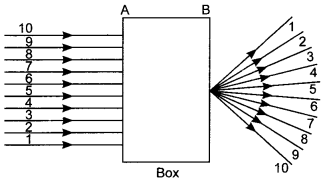
#33. A beam of light is incident through the holes on side A and emerges out of the hole on the other face of the box as shown in the figure. Which of the following could be inside the box?
Explanation: (d) From figure, it is clear that parallel rays converge at a point and emerges from face B. So convex lens would be possible inside the box.
#34. When object moves closer to convex lens, the image formed by it shift
Explanation: (a) As object moves from infinity towards optical centre of the convex lens image is shifted away from its focal point and towards infinity.
#35. Which of the following statements is/are true?
Explanation: (a) Positive sign with power and focal length indicates that the given lens is convex.
Also f = 1P=14 = 0.25m
#36. In which of the following, the image of an object placed at infinity will be highly diminished and point sized?
Explanation: (d) The incident ray coming from the object placed at infinity will be parallel to the principal axis. When the parallel beam of light incident on a mirror or lens, irrespective of their nature, after reflection/refraction, will pass or appear to pass through their principal focus. Hence highly diminished and point size image will be formed at their focus.
#37. The refractive index of transparent medium is greater than one because
µ=speed of light in Vacuum (c)/speed of light in medium(v)
- As c> v so µ>1
#38. For a real object, which of the following can produce a real image?
Explanation: (b) Only concave mirror can produces a real image for the any position of object between its focus and infinity.
#39. As light travels from a rarer to a denser medium it will have
Explanation: (d) When light ray travel from rarer to denser medium, its velocity and wavelength both decrease as v = vλ.


